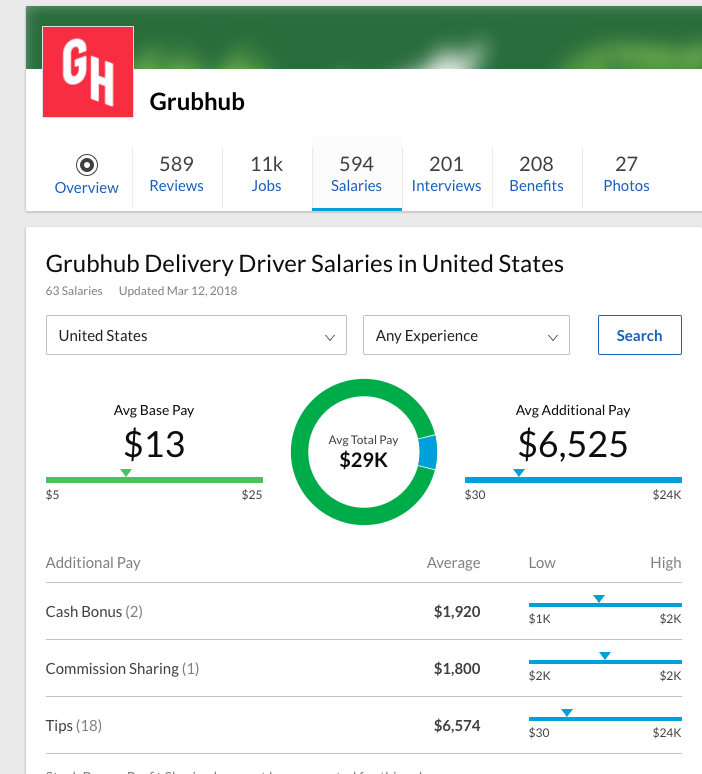Grubhub Business Model and Revenue Model: How Does Grubhub Make Money?

Grubhub Business Model and Revenue Model: How Does Grubhub Make Money?
The best part of answering the question of how GrubHub works is that it gives you a clear picture of the industry. The on-demand food delivery service business has grown at a rapid pace, thanks to the smartphone revolution and the changing preferences of consumers. Once you understand the GrubHub business model, you have pretty much understood the on-demand food delivery industry.
What is GrubHub?
GrubHub is a technology-driven, on-demand food delivery solution that uses its website and mobile applications to connect customers and diners. Its web-based and mobile application allows customers to order food online and have it delivered at a location of their choice. GrubHub was founded in 2004 by Matthew Maloney and Michael Evans.
It is important to note that GrubHub doesn’t own a single restaurant anywhere, and it delivers food through paid delivery persons. It gives customers the food of their choice at their own convenience and grants restaurants and diners access to a customer base that they may not have served otherwise.
GrubHub is headquartered in Chicago, Illinois. It is an NYSE-listed, public limited company (NYSE: GRUB).
GrubHub Mergers and Acquisitions
For an organization that is barely 16 years old, GrubHub has made a considerable number of acquisitions. As a matter of fact, mergers and acquisitions seem to work rather well for the GrubHub business model.
| Acquired organization | Year |
| Eat24 | 2017 |
| Foodler | 2017 |
| Dashed | 2017 |
| LAbite | 2016 |
| Bask Labs, Inc | 2016 |
| Delivered Dish | 2015 |
| DiningIn | 2015 |
| Seamless | 2013 |
| FanGo Software | 2011 |
Meanwhile, in 2013, after Seamless’s merger with HubGrub, one more company, apart from Seamless, came under GrubHub’s fold: MenuPages, which had been acquired by Seamless in 2011.
GrubHub in Numbers

GrubHub Funding

GrubHub Business Model: How GrubHub benefits customers and restaurants
GrubHub uses the on-demand food delivery business model in a way that benefits both customers and restaurants.
Following are some of the ways Customers benefit from GrubHub because
- Ordering through GrubHub gives them a wide variety of choices.
- Customers can save their favorite order and payment information.
- Using GrubHub, finding a restaurant online is easier and faster.
- Customers can track delivery of the food ordered through GrubHub.
Restaurants too are at an advantage with GrubHub because
- Restaurants get access to the proven ordering GrubHub platform.
- The best part is, perhaps, the entire access to customer analytics and preferences.
- They get discovered by customers who otherwise may have never found them.
- Restaurants can focus on making great food and let GrubHub worry about delivery.
- Online ordering can take in a lot more orders than over a phone-line.
GrubHub Revenue Model: How does GrubHub make money
GrubHub is purely a logistics company. The GrubHub revenue model is that of a service-aggregator – it serves food to hundreds of thousands of customers, but it doesn’t own any restaurant.
While studying how GrubHub makes money, it’s important to understand that the robust technology they have built helps them smoothen out a great number of processes and makes them ultra-cost-effective. Once a business has in place great technology with every feature, things become a great deal easier.
GrubHub has two sources of incomes
- GrubHub commission from partnering restaurants
- Advertisement revenue from GrubHub platforms
GrubHub commission from partnering restaurants
Restaurants benefit from the strong delivery model GrubHub has in place. In exchange, GrubHub charges a commission from the restaurants.
Commission rates range between 5% and 15% of the gross value of the order. That means for an order of $100, the restaurant may pay a commission between $5 and $15 to GrubHub. If you average out the values, it comes to 10% commission rates.
The GrubHub prospectus, filed with the SEC in 2013, allowed analysts to do some quick calculations. GrubHub reported a little over $1 billion in delivery and pick-up orders. Against that, it generated $137 million in revenue from these transactions. That suggests the average GrubHub commission rate is 13.5%.
Advertisement revenue from GrubHub platforms
Customers search for restaurants from the GrubHub platforms – website and mobile phone applications. Restaurants can choose to promote themselves through advertisements.
Under the various promotional plans, restaurants can choose to have themselves listed higher or in special positions where they can be easily noticed by customers. The rates for such promotions vary and depend upon factors like the duration of promotion, commission rates a restaurant offers to GrubHub and competition in the particular space.
How to become a GrubHub driver
No discussion of the GrubHub business model can be complete with a brief note on how one becomes a GrubHub driver.
The minimum age to be considered as a GrubHub driver is 19+ (except Chicago, where it’s 21+). The candidate should hold a valid driving license with 2+ years of driving experience and auto insurance. A checking bank account is a must. Finally, GrubHub will carry out a background check.
The job of a GrubHub driver is that of driving to collect orders and making deliveries. Hence the routine skills of a delivery man are highly desirable.
How much does a GrubHub driver make?
Now the important part: how much does GrubHub pay? Since the exact data is difficult to calculate, we relied on estimates by Glassdoor. The typical GrubHub delivery driver salary is $13. Based on the earnings reported as well as independent estimates of additional compensations and bonuses, Glassdoor believes that an average GrubHub driver makes an average total pay of $ $27k – 29k.

It must be noted that GrubHub drivers are legally classified as independent contractors and not as employees. Hence, they are not eligible for benefits that an employee is.
4 Top reasons GrubHub is successful
There are so many reasons why GrubHub is so successful. We’ll list out the 4 reasons GrubHub is successful.
- It has leveraged technology to scale up fast. Without technology, it’s unlikely that GrubHub, or for that matter even similar businesses could have existed.
- It entered relatively early and swiftly built its base of partner restaurants. In the on-demand food delivery business, this was very important to grow together.
- It has balanced its expenses and commissions well. Startups quickly bleed to death when they can’t manage their finances.
- In spite of being an online services company, it has managed offline marketing well in the past. Billboards, transit hubs, buses, subways and so on were used to promote GrubHub.
So this is the business model of GrubHub in detail. Feel free to shoot questions you think are relevant to this type of business. We’ll be glad to be of assistance!
If you’re looking to build the next GrubHub, Then get in touch with us, we at Infigic provides on-demand food delivery app development solution to build the next GrubHub











